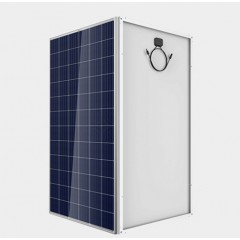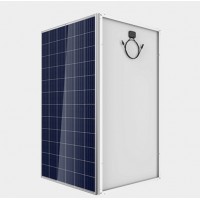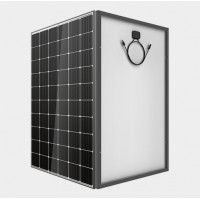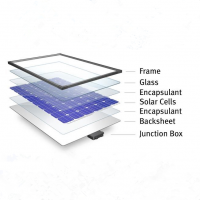It’s does not require fossil fuels so that can saved the cost from the fossil fuels ,less dependent on this limited and expensive natural resource.
2. Environmental Advantages
Solar power production generates electricity with a limited impact on the environment as compared to other forms of electricity production.
3. Matching Peak Time Output with Peak Time Demand
Solar energy can effectively supplement electricity supply from an electricity transmission grid, such as when electricity demand peaks in the summer.
4. Modularity and Scalability
As the size and generating capacity of a solar system are a function of the number of solar modules installed, applications of solar technology are readily scalable and versatile.
5. Flexible Locations.
Solar power production facilities can be installed at the customer site which reduces required investments in production and transportation infrastructure.
Solar photovoltaic (PV) are considered as the most cleanable & renewable energy, that convert energy from daylight directly into electricity, and are now becoming a leading role of the electricity generation mix worldwide.
|
High Module Conversation Module efficiency up to 17.1% achieved through advanced cell technology and manufacturing capabilities
Excellent Weak Light Excellent performance under low light conditions
Positive Tolerance Positive tolerance of up to 5W delivers higher outputs reliability
New Sorting Process System output maximized by reducing mismatch losses up to 2% with modules sorted &packaged by amperage
Extended Wind and Snow and Load Tests Module certified to withstand extreme wind (3800 Pascal) and snow loads (5400 Pascal)
3bus Bar Design Two bus bar design enhances cell reliability and reduces seri-es resistance for large fill factor
|
 |
| SY6-36 | SY6-60 | SY6-72 | |
|
Peak Power Pm(W) |
140-160 | 230-270 | 275-325 |
|
Maximum Operating Voltage Vmp(V) |
17.9-18.32 | 30.01-30.93 | 36.16-37.4 |
|
Maximum Operating Current Imp(A) |
7.82-8.73 | 7.66-8.73 | 7.6-8.69 |
|
Short Circuit Current Isc(A) |
8.51-9.16 | 8.27-9.16 | 8.42-9.03 |
|
Open Circuit Voltage Voc(A) |
22.4-23.1 | 37.84-38.57 | 44.64-46.46 |
| Operating Module Temperature | -40 °C to +85 °C | ||
| Maximum System Voltage | 1000 V DC (IEC) | ||
| Maximum Series Fuse Rating | 15A | ||
| Power Tolerance | 0/+5 % | ||
| STC: lrradiance 1000 W/m 2 , module temperature 25 °C, AM=1.5;
Best in Class AAA solar simulator (IEC 60904-9) used, power measurement uncertainty is within +/- 3% |
|||
Temperature Characteristics |
|||
| Nominal Operating Cell Temperature | 45±2°C | ||
| Temperature Coefficient of Pmax | -0.43 %/°C | ||
| Temperature Coefficient of Voc | -0.33 %/°C | ||
| Temperature Coefficient of Isc | 0.067 %/°C | ||
Mechanical Characteristics |
|||
| Solar Cell |
156 × 156 mm 6 × 6 inches |
156 .75× 156 .75mm 6 × 6 inches |
156.75 × 156.75 mm 6 inches |
| No. of Cells | 36 (4 × 9) | 60 (6 × 10) | 72 (6 × 12) |
| Dimensions |
1482 × 676 × 40mm 58.3 × 26.6 × 1.4 inches |
1640 × 992 × 40mm 64.6 × 39.1 × 1.4 inches |
1956 × 992 × 40mm 77.0 × 39.1 × 1.6 inches |
| Weight |
12 kgs 26.4 lbs. |
19.5 kgs 40.1 lbs.) |
22.5 kgs 56.9 lbs. |
| Front Glass |
3.2 mm 0.13 inches) |
3.2 mm 0.13 inches |
4.0 mm 0.16 inches |
| frame | Anodized aluminium alloy | Anodized aluminium alloy | Anodized aluminium alloy |
| Junction Box | IP67 rated (3 bypass diodes) | IP67 rated (3 bypass diodes) | IP67 rated (3 bypass diodes) |
| Output Cables | PV1-F4.0 mm 2(0.006 inches 2 ), symmetrical lengths (-)1000mm (39.4inches) and (+) 1000 mm (39.4 inches) | PV1-F4.0 mm 2(0.006 inches 2 ), symmetrical lengths (-)1000mm (39.4inches) and (+) 1000 mm (39.4 inches) | PV1-F4.0 mm 2(0.006 inches 2 ), symmetrical lengths (-)1000mm (39.4inches) and (+) 1000 mm (39.4 inches) |
|
Connectors |
Sunter PV-ZH202/MC4 IP67/IP2X | Sunter PV-ZH202/MC4 IP67/IP2X | Sunter PV-ZH202/MC4 IP67/IP2X |






